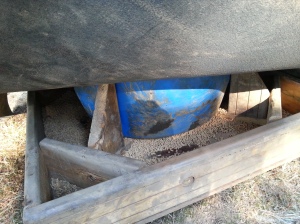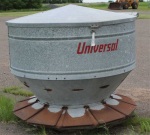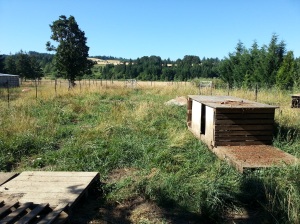I was recently asked to answer a series of questions about my farm for a feature article on the Oregon Entrepreneurs Network newsletter/blog. The full text is here: https://www.oen.org/2018/12/10/rising-star-matt-alford/
It’s been suggested to me that I share my thoughts with state government as to whether I feel that Oregon is a good place to start a business. I forwarded the article to Governor Kate Brown and Oregon Department of Agriculture Director Alexis Taylor. I thought I might expand on it a bit here as well.
I’ve been raising hogs commercially for four years now. I started out selling direct to consumers, then I added restaurant accounts, tried to get into Whole Foods and institutions like OHSU, and now I’ve come full circle and I’m back selling exclusively direct to consumers. In many ways, my farm is starting over after a four year startup journey. I’m no longer test driving markets and learning the ropes. I know what I need to know now.
One thing that has massively changed since I started this journey is the collapse of our slaughter options. I remember back in the fall of 2014 when my hogs reached market weight, I called around in October looking to book a slaughter appointment and was dismayed that I had to wait three weeks for an appointment. Now, four years later, the lead time has gone from three weeks to six months for cattle and two months for hogs. Our slaughterhouses have steadily gone out of business over the last four years, driving up lead times at the ones that are still operating. One of my former farm employees now works as a meat cutter at a local slaughterhouse and he routinely puts in 12 – 13 hr days. He tells stories of new employees quitting after just one day because the work is hard and the hours are long. Every year the slaughterhouses increase their prices and yet their demand keeps going up as facilities close.
This problem is extra acute for my farm, where I sell not only whole and half hogs, but individual cuts of meat as well, which are subject to USDA federal regulations. Oregon used to have a state inspected meat program, but dropped it when the federal government passed the Wholesome Meat Act in 1967. In short, beef and pork that is to be sold to the general public (restaurants, grocery stores, individual cuts, and meat that is to be resold as through distribution) must be slaughtered, cut, and wrapped under the watchful eye of a USDA federal inspector. Recognizing that farmers often raise animals for their own personal consumption, the state allows an exemption: if you raise an animal for personal consumption, it may be slaughtered on the farm by a state-licensed slaughter business and then cut/wrapped in a state-licensed facility under what is knows as the “custom exempt” rule. It’s this rule that allows me to sell you a whole or half hog, have it dispatched on the farm (rather than trucking the hog to a USDA facility) and then have it cut/wrapped at a non-USDA butcher shop such as The Meating Place in Hillsboro. But if you want to just buy pork chops from me, that hog has to be slaughtered, cut, and wrapped at a USDA facility. If I want to sell to Whole Foods or a restaurant or the OHSU cafeteria, that meat has to go through a USDA plant.
USDA slaughterhouses are few and far between. It costs a lot of money to pay federal inspectors and those costs get passed on to the farmers and consumers in the form of higher slaughter and cut/wrap fees. USDA slaughter schedules fill up quickly and when the plant breaks down, there aren’t other places to go. It’s a system that’s breaking and the cracks have been showing up for years. People who started their slaughter/cut/wrap business back in the 1960’s and 70’s are now retiring and there are few people who can step up and keep those businesses running. Those who are trying are having a rough go of it. All of this rolls downhill and impacts small livestock farmers like me. I could have sold more pork this fall if I could have secured USDA slaughter/cut/wrap services, but the lead time was too long and I couldn’t get on the schedule in time.
Oregon custom exempt slaughter rules are a mess. If you raise poultry, Oregon allows you to slaughter up to 1,000 chickens per year on the farm without any USDA supervision or state licensing as long as you sell the chickens farm-direct to consumers. Farmers can sell up to 20,000 birds/year through distribution if the birds are slaughtered at a state-licensed facility. If you raise over 20,000 birds, then they have to go through federal inspection. Hogs and cattle have no similar exemptions. It doesn’t matter how many hogs or cattle the farmer raises, the meat cannot be sold through distribution, farm direct, or at a farmers market as individual cuts of meat unless the animals goes through USDA processing. Yet bison can be slaughtered at a state-inspected facility and sold at farmers markets. This patchwork of species-specific exemptions is maddening and makes no sense whatsoever.
It’s time for Oregon to reinstate its state-inspected meat program. All meat that is slaughtered, and cut/wrapped in state-inspected facilities should be allowed to be resold at farmers markets, grocery stores, and public restaurants/cafeterias within Oregon. Get rid of the volume limits, species-specific rules, and the sale restrictions. The program could be fully funded by user fees (the same way farmers fund the ODA inspections today through meat license sales). Not only would this be better for business, but it would be better for animal welfare. Transporting livestock is stressful for the animals and the handlers. On-farm slaughter is more humane and a state-inspected meat program would make this option more readily available.
I’ve heard rumors that a state inspected meat program has been discussed at the state capital, but I am not aware of any plans or progress toward making it a reality. If you’re a believer in humanely raised, local meat, this legislation is “must have” and the longer it takes to get enacted, the more farms will cease to exist. If you care about this, please write our governor and ODA director. I’m just one voice, but if you add yours, maybe someone will finally listen.
Oregon Governor Kate Brown: https://www.oregon.gov/gov/Pages/share-your-opinion.aspx
ODA Director Alexis Taylor: ataylor@oda.state.or.us
Thanks.
–MATT















 The effect of that was that the pigs could really only access the feed on two sides. Not terrible, but not ideal either. About the time I reached this point in my feeder experiments, winter was upon me and I had to do something to keep the water out of the feeder. I resorted to t-posts and a tarp over the feeder. I didn’t want to go there because tarps don’t last, especially in high wind. If you go this route, you really need to attach every tarp grommet to a t-post else the wind will rip out the grommets that are attached. I ended up using bungee cords to attached the tarp to the posts, attaching one end of the bungee to a grommet, wrapping the cord around a post, then attaching the other end to the next grommet (one bungee covers two grommets). That worked out well, allowing the tarp to flex in the wind, but not rip.
The effect of that was that the pigs could really only access the feed on two sides. Not terrible, but not ideal either. About the time I reached this point in my feeder experiments, winter was upon me and I had to do something to keep the water out of the feeder. I resorted to t-posts and a tarp over the feeder. I didn’t want to go there because tarps don’t last, especially in high wind. If you go this route, you really need to attach every tarp grommet to a t-post else the wind will rip out the grommets that are attached. I ended up using bungee cords to attached the tarp to the posts, attaching one end of the bungee to a grommet, wrapping the cord around a post, then attaching the other end to the next grommet (one bungee covers two grommets). That worked out well, allowing the tarp to flex in the wind, but not rip.











